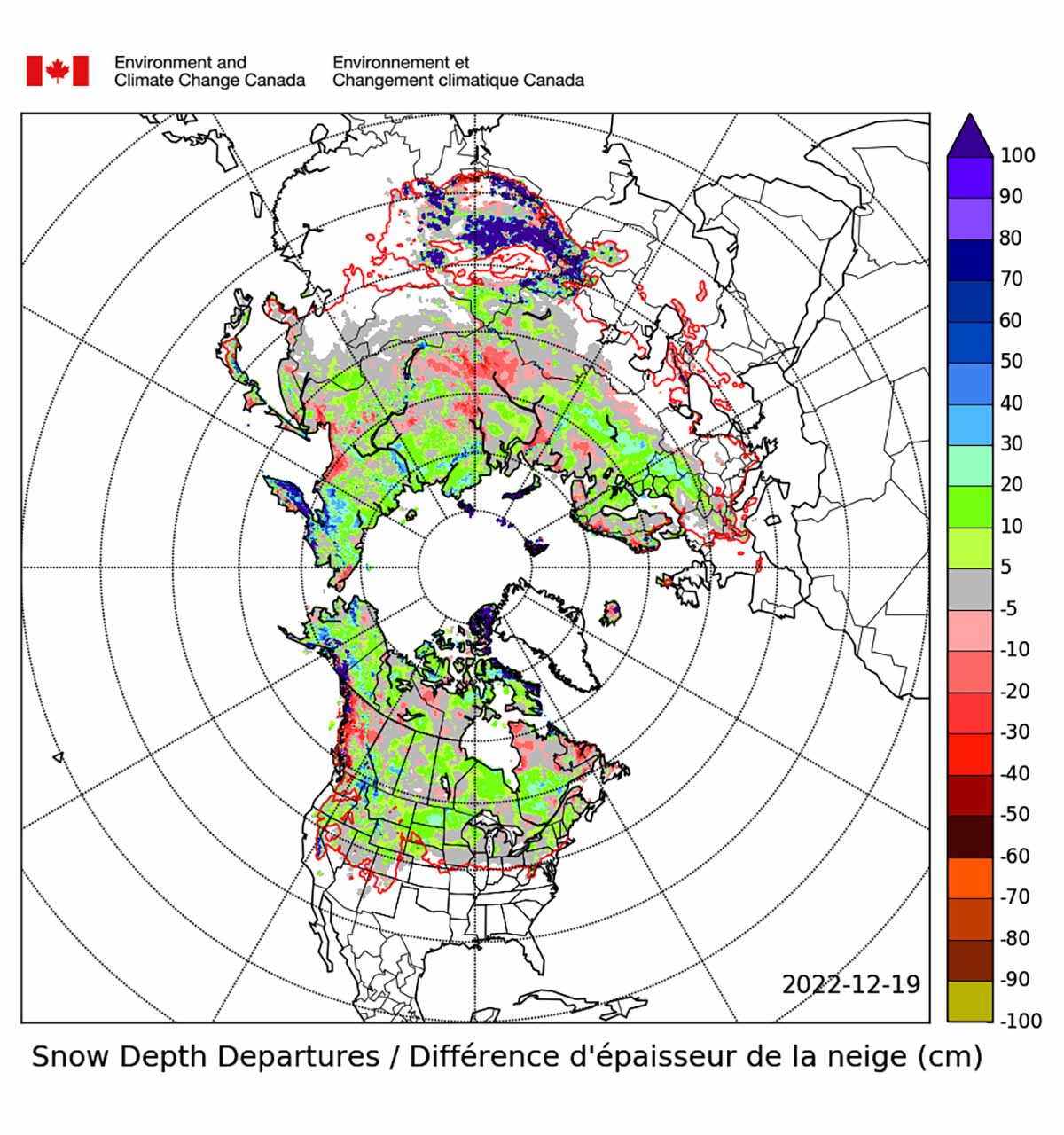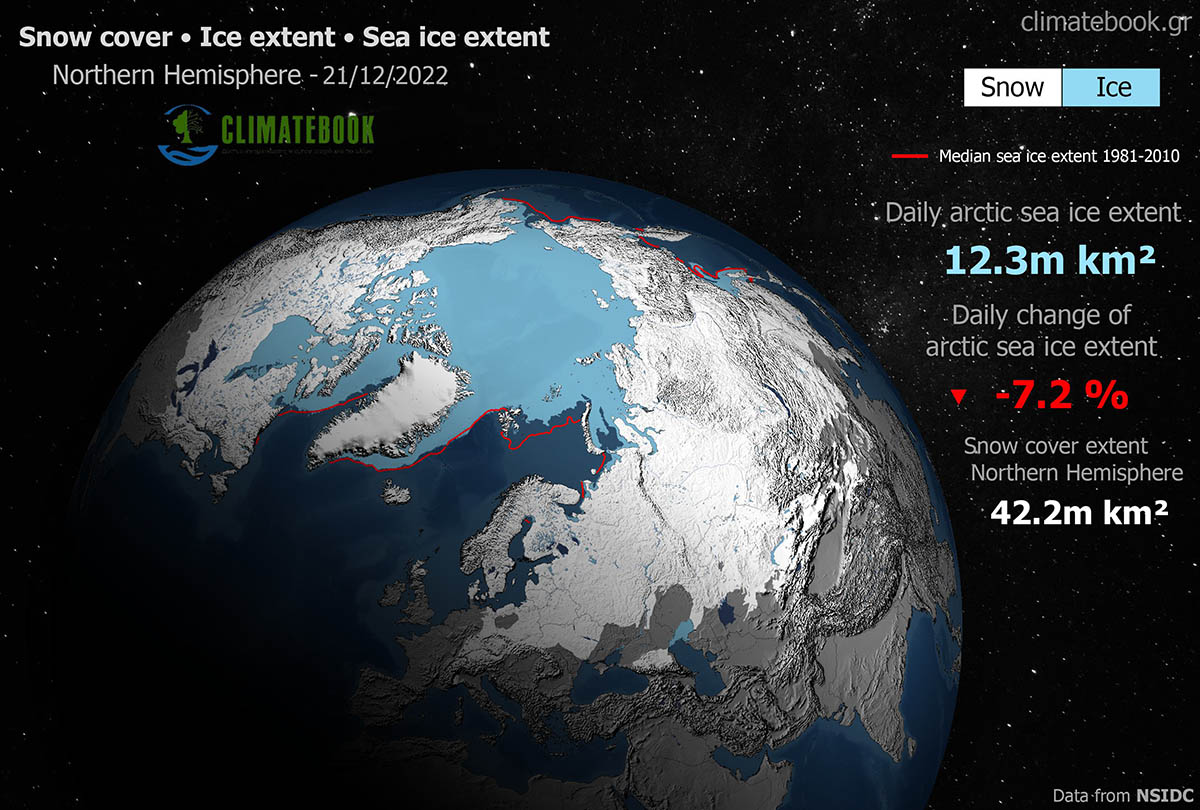Snow extent in the Northern Hemisphere keeps rising much higher than average, according to updated global estimates in December. Meanwhile, the winter storm Elliot in North America is on its way to sudden increase the current snow extent by about 1 million square kilometers. Winter forecasts have already been strongly influenced by such a large snow extent, both in North America and Europe. Arctic cold spell spreading, especially over the UK and Central Europe in the last weeks, recorded temperatures much lower than average. The updated snow forecast doesn’t give room for misinterpretations. The snow extent will keep rising in the next weeks, although not equally in the Northern Hemisphere.
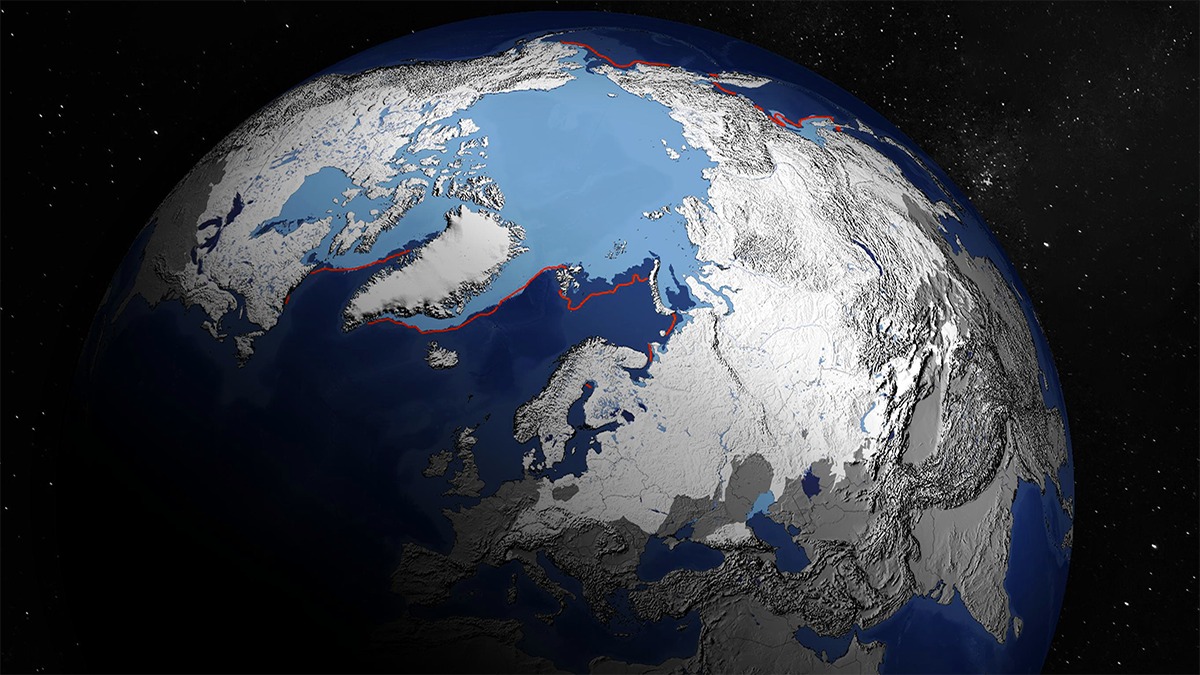
SNOW EXTENT REPORT FROM NORTH AMERICA AND EUROPE
In this early winter phase, there is no shortage of snow on the ground in the Northern Hemisphere. After breaking a weekly record only one month ago in November, substantial snow extent remains well above the 56-year mean, now at about 45 million square kilometers, according to the NOAA/Rutgers Global Snow Lab.
Yet, western Europe is facing in these hours a fast snow extent reduction after the Arctic freeze came to an end a few days ago, with a massive surge of warmth bulldozing in from the Atlantic. Some places in Central Europe and UK were more than 20°C warmer by night. Snow extent in Europe is now 6.8 million square kilometers, according to data from NSIDC. This means 62.4 percent of the land is covered by it.
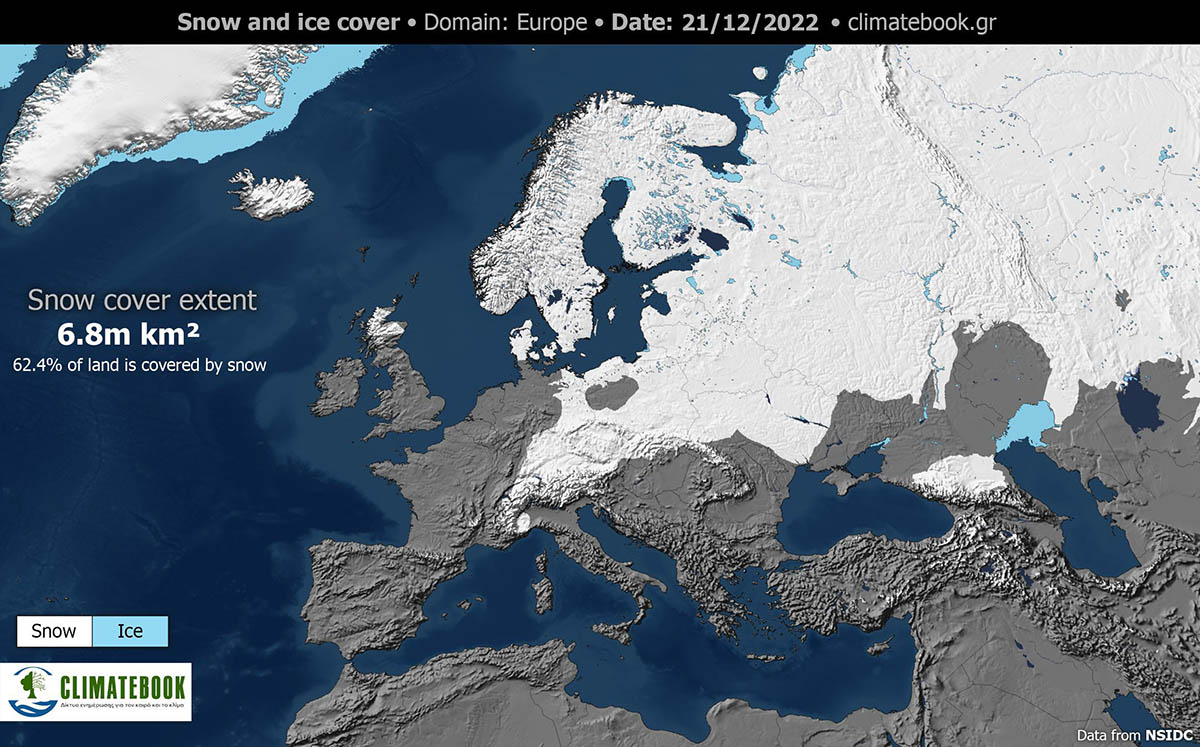
map source ClimateBook
But on the other side of the Atlantic, the emerging weather situation across North America developed a noticeable dipole weather pattern beneath the front edge of the Polar Vortex lobe aloft.
This winter storm leads to a considerable transport of a highly chilly Arctic air mass from west-center Canada into the central part of North America first and towards the East coast second. The interaction of the Arctic frigid air mass with warmer and moist air mass will provide sufficient energy for an impressive cyclonic system to develop immediately.

This huge winter storm, Elliott, will bring widespread blizzards with a lot of new snow covering the ground. The snow forecast predicts a lot of new snow to fall. Therefore, its extent in North America will increase more in the next few days.
The most recent available weekly Northern Hemisphere snow cover extent, given in the image above, for the winter season 2022-2023 in purple is plotted together with the mean (grey dashed line) and minimum (orange), and maximum (blue), snow extent for each week. Mean weekly snow cover extent and extremes were calculated using the 56 years from October 1966 to July 2022.
Besides extent, another parameter is the snow depth. Environment and Climate Change Canada delivers a snapshot of the present daily snow situation in the context of historical means. This snow anomaly tracking application, updated daily, displays a map of spatial snow depth anomalies and six-time series of snow cover extents and water equivalents.
Specifically, using the map below, we can see the difference in snow depth (in centimeters) between the current daily thickness and the average over the period of 1998/1999 through 2011/12. Areas where the current snow depth is within a range of 5 centimeters of the historical average are shaded gray. The thick red contour line shows the historical location of the snowline and indicates a 50% probability of snow depth equal to or greater than 2 centimeters.
map source Environmental and Climate Change Canada
Again, looking at the below Rutgers Daily Snow Extent map on 18 December, it is noticeable how Russia and Eastern Europe (except Hungary, Romania, and the Balkans) are completely covered now. Snow is also overwhelming all of Canada, Alaska, and a good portion of the Lower 48. Snow forecast, for this reason, is, of course, also an essential parameter for early winter forecast.

map source Global cryosphere watch
The Balkans are the area in Europe where the most significant negative anomaly is reported. In the image below, we can see how Slovenia, Croatia, Hungary, Serbia, Albania, Romania, Bulgaria, and Greece are virtually free of snow, except in scattered locations in the Dinaric Alps. Here snow forecasts are indeed not optimistic for the near future.
On the other side, the white blanket at low elevations in the western Po Plain in the Piedmont Region, Italy, is remarkable. On the contrary, the Apennines at higher elevations show a scarce snow cover. Looking at Sicily in southern Italy, you can see the Etna volcano with a small blanket of snow on the top.
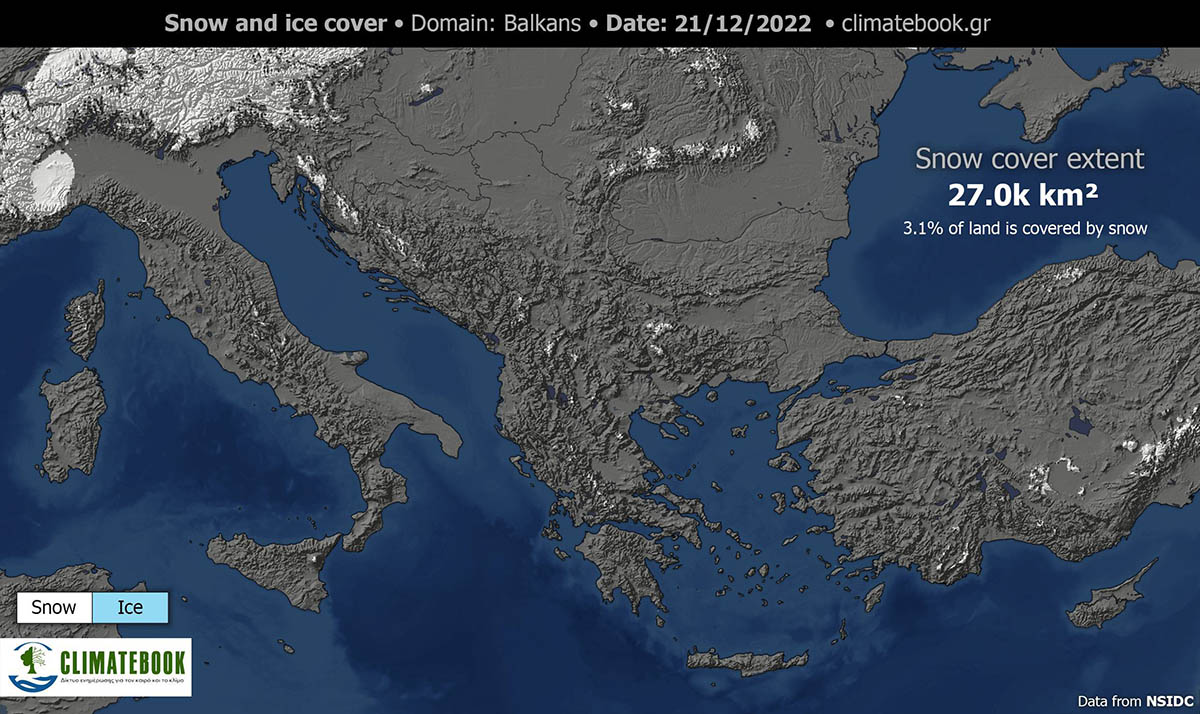
map source ClimateBook
The image below shows the daily snow cover departure from the long-term average. In blue and red, we can see the positive (more snow extent than the long-term average) and negative (less snow extent than the long-term average) anomalies. In Eurasia, vast areas with more significant snow extent persist, especially over the UK and central European countries and in northern China.
In North America, snow extent is more south than average almost everywhere. Very few minor, scattered negative anomalies are less significant in the picture.
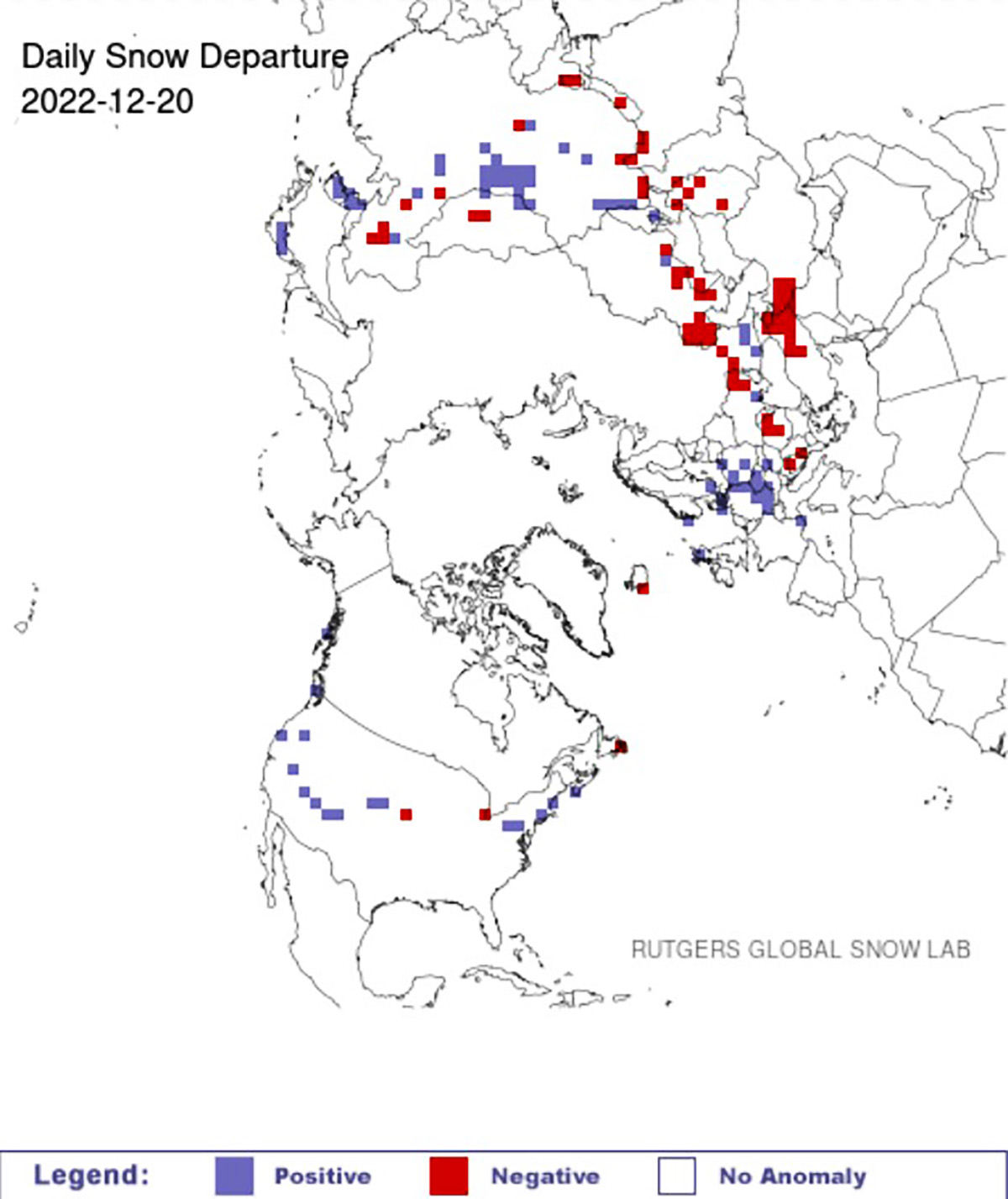
According to the Finnish Meteorological Institute, also the total snow mass for the Northern Hemisphere is tracking well above the 1982-2012 average. This result is based on the current Northern Hemisphere snow-water equivalent relative to the long-term mean and variability.
This diagram unequivocally shows how snow mass during winter 2022-23 has been steadily above average. The latest observation available is that one from 18 December.
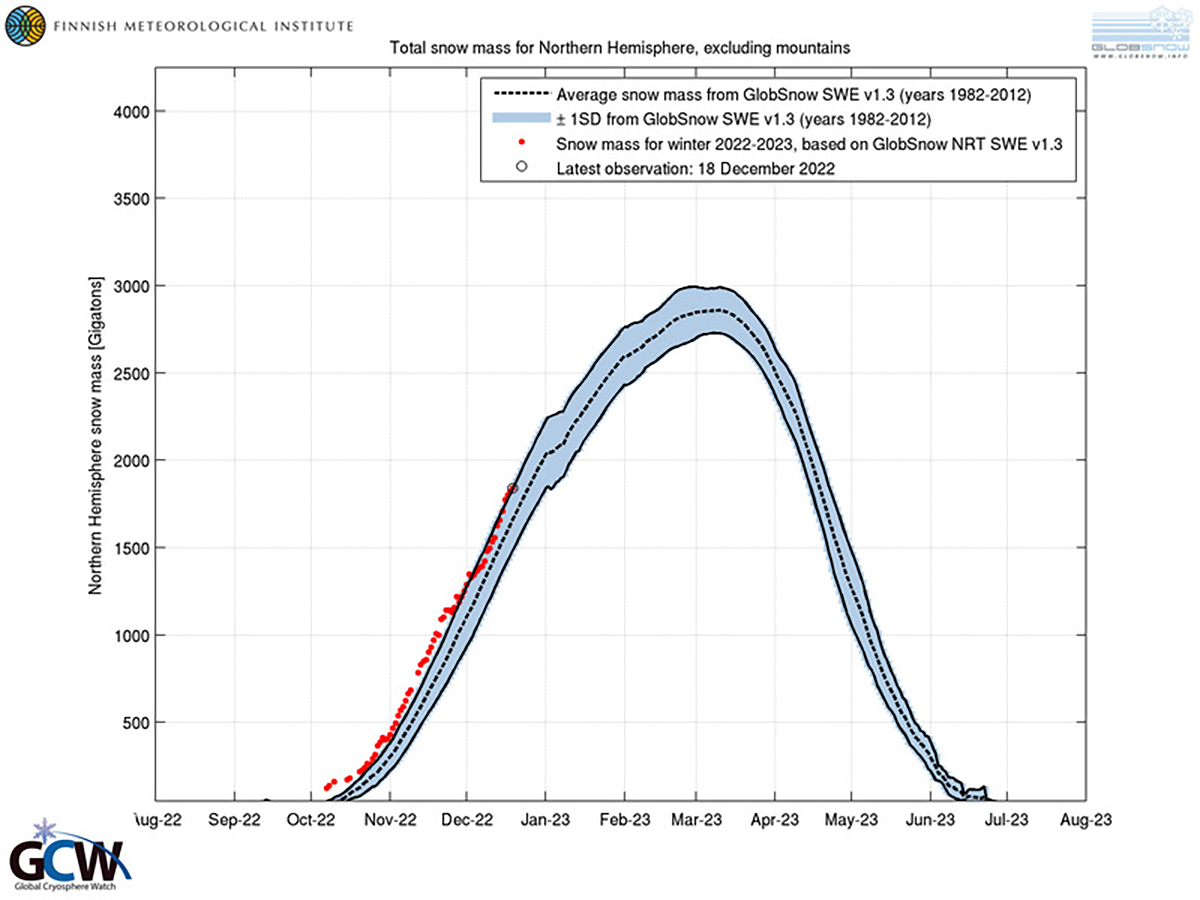
The image below shows a stunning view from space on 15 December courtesy of NASA’s worldview. Extensive snow cover across portions of Southern Britain, where temperatures haven’t risen above -2°C not even during the day in some areas, despite wall-to-wall sunshine.
This is pretty unusual for southern England. North Sea moisture brought snow showers in part of Norfolk as well, visible as those dusting of white.
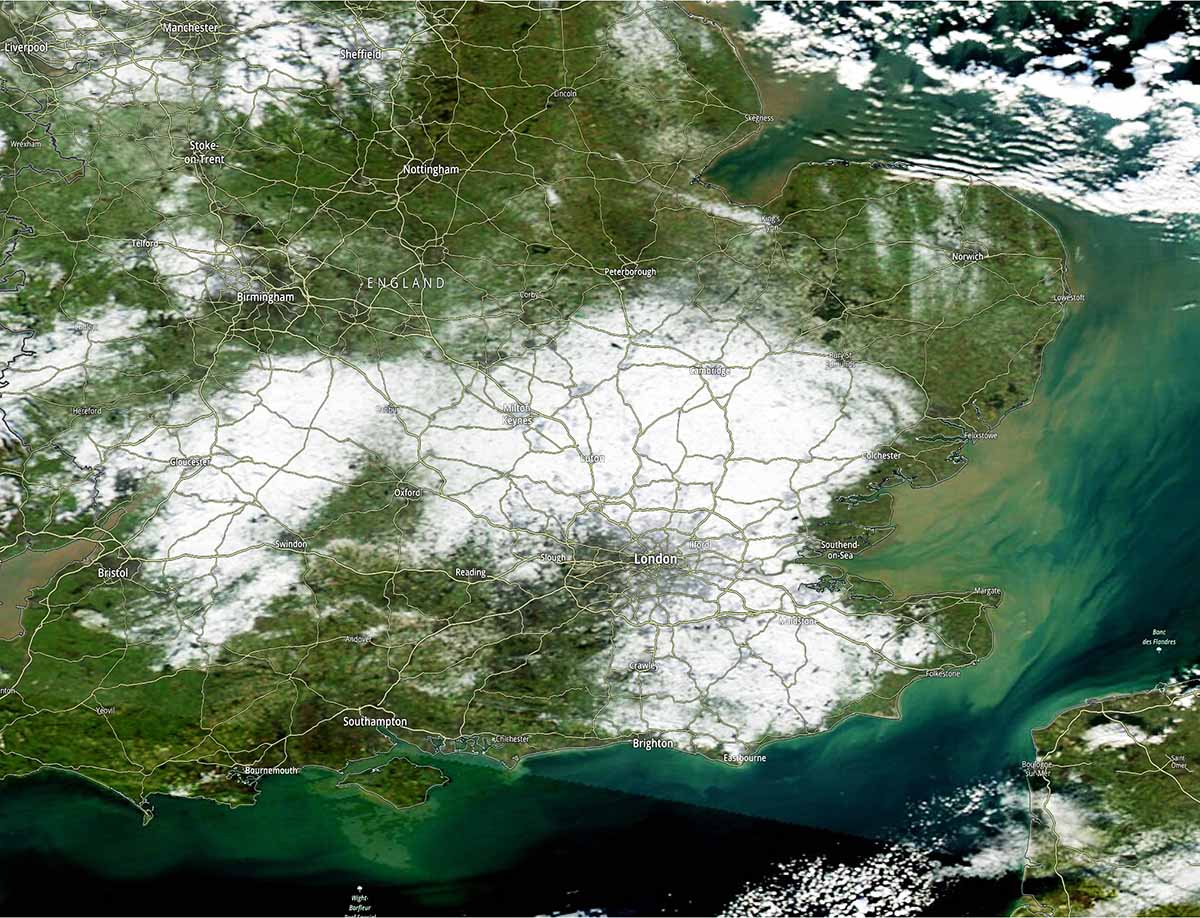
Generally, snow extent in the northern hemisphere grew fast in the last month, as it should generally be in this course period. Nevertheless, the end of 2022 is setting a favorable season for snow. The good snowy season started in Autumn.
According to data from the Rutgers Global Snow Lab, Northern Hemisphere snow extent during November was 1.04 million square miles above average. This ranks as the fourth-largest Northern Hemisphere snow extent on record. Snow extent was above average, especially in North America, Greenland, and Eurasia.

According to the National Centers for Environmental Information based at NOAA, this estimate is even higher. In the Northern Hemisphere, snow extent was 37.75 million square kilometers with a positive anomaly of +2.70 million square kilometers. The most significant snow extent reached 38.60 million square kilometers in 1993.
It is interesting to see how the actual trend per decade is somewhat optimistic and equal to +0.51 million square kilometers.
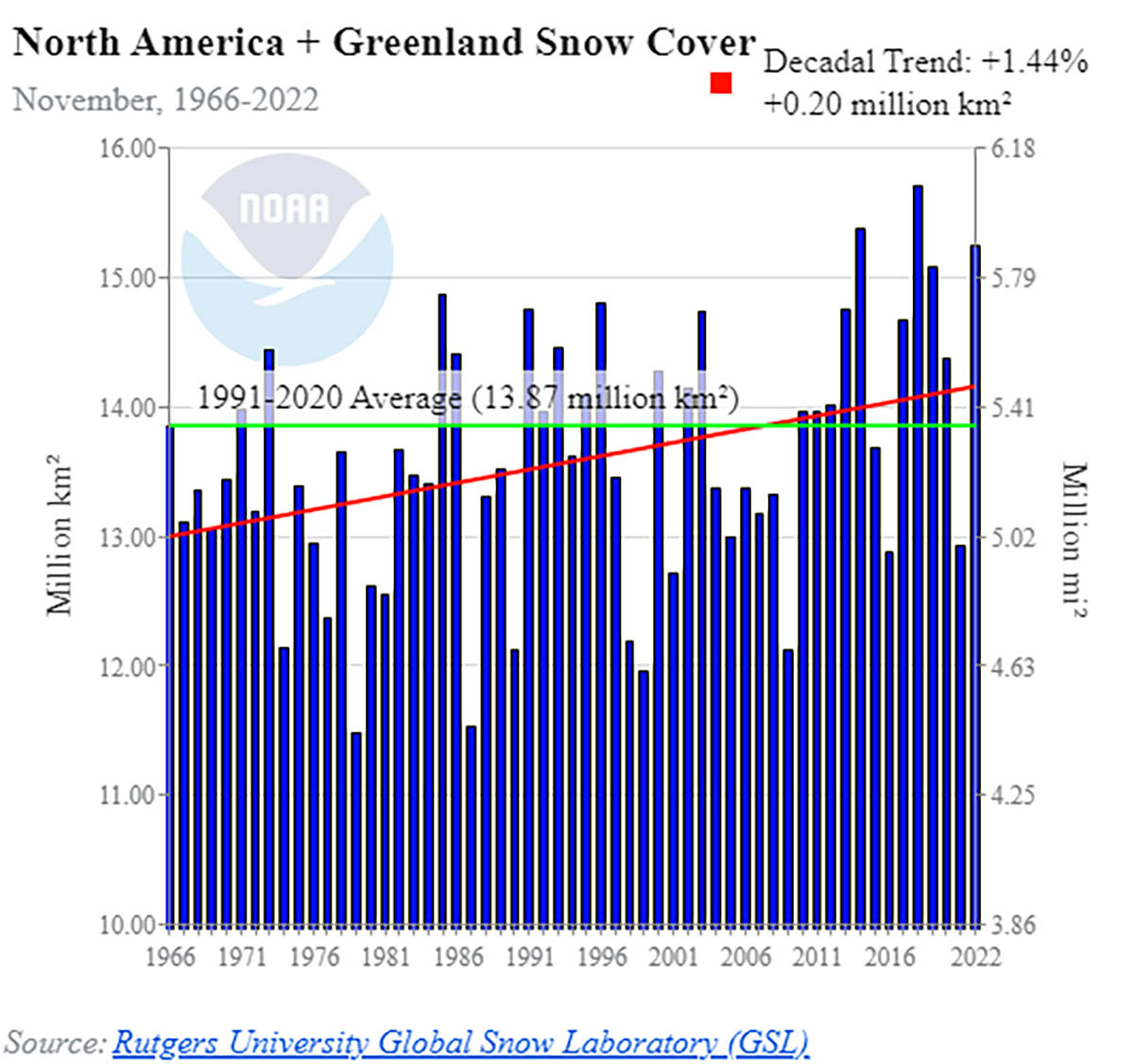
When looking at the North American and Greenland snow extent, we get 15.25 million square kilometers, which is 1.38 million square kilometers above the 1991-2020 average. This ranks as the third-largest snow cover extent for North America on record.

Europe and Asia have also recorded an above-average snow extent for November at 22.49 million square kilometers. This is 1.31 million square kilometers more than the 1991-2020 average, ranking as the 11th-largest November snow extent in 56 years of available observations.
The extent was below-average in southeastern Europe, Turkey, and the South Caucasus. Above-average snow extent was instead observed over most of Russia and northeastern China, as well as across parts of Scandinavia, northeastern Europe, Kyrgyzstan, and eastern Kazakhstan.
map source ClimateBook
Snow extent in Autumn is essential because you could probably forecast a colder-than-normal early winter based on Autumnal Northern Hemisphere snow extent alone. Having a lot of snow on the ground means arctic outbreaks will be slightly colder. And this is indeed what happened this year with the early December arctic cold outbreaks affecting North America and Europe.
A new, powerful Arctic cold spell is now developing in North America. Also, Siberia experienced a pronounced cooling in December this year. But why is this so important when looking at the scale of the Earth?
Temperature is always colder on the ground in winter and night in calm conditions, without or with the very weak wind. That’s because the Earth warms up and cools off much faster than the atmosphere. Furthermore, colder air is denser; therefore, the air near the ground is colder at night than the higher air. That’s why your thermometer says +1 or +2 degrees Celsius, but you might see frost on the ground.
SNOW COVER AND EXTENT ARE IMPORTANT CLIMATE FEEDBACKS
Extensive snow extent indicates persistent cold as we head into winter proper, mainly due to two fundamental parameters.: albedo and emissivity feedback.
Albedo is defined as the fraction of light that is reflected by a body or surface. On average, the Earth reflects about 30 percent of the sun’s radiation, but when fresh snow covers the ground, that value nearly triples and is close to 1.0. Snow has the most significant albedo on Earth, from less than 0.60 for wet and melting snow to greater than 0.85 for fresh snow.

The albedo of fresh snow could be as higher as 0.95, reflecting on spacing 95 percent of the sun’s radiation, keeping the ground and air much more relaxed. See the image below courtesy of NASA to understand how a white blanket of snow covering the Highlands in Scotland can reflect much of the solar radiation to space while the darker marine surface much less.
It represents an essential parameter in climatology since recent albedo decreases in the Arctic have increased heat absorption at the surface leading to the so-called Arctic Amplification. Practically, Arctic lands and sea are warming faster than other environments on Earth due to the positive feedback induced by the darker surface of the land and sea in summer, where there is no snow or ice on the ground or sea ice melted. The effect is predominant during the summer when sunlight is at its highest.
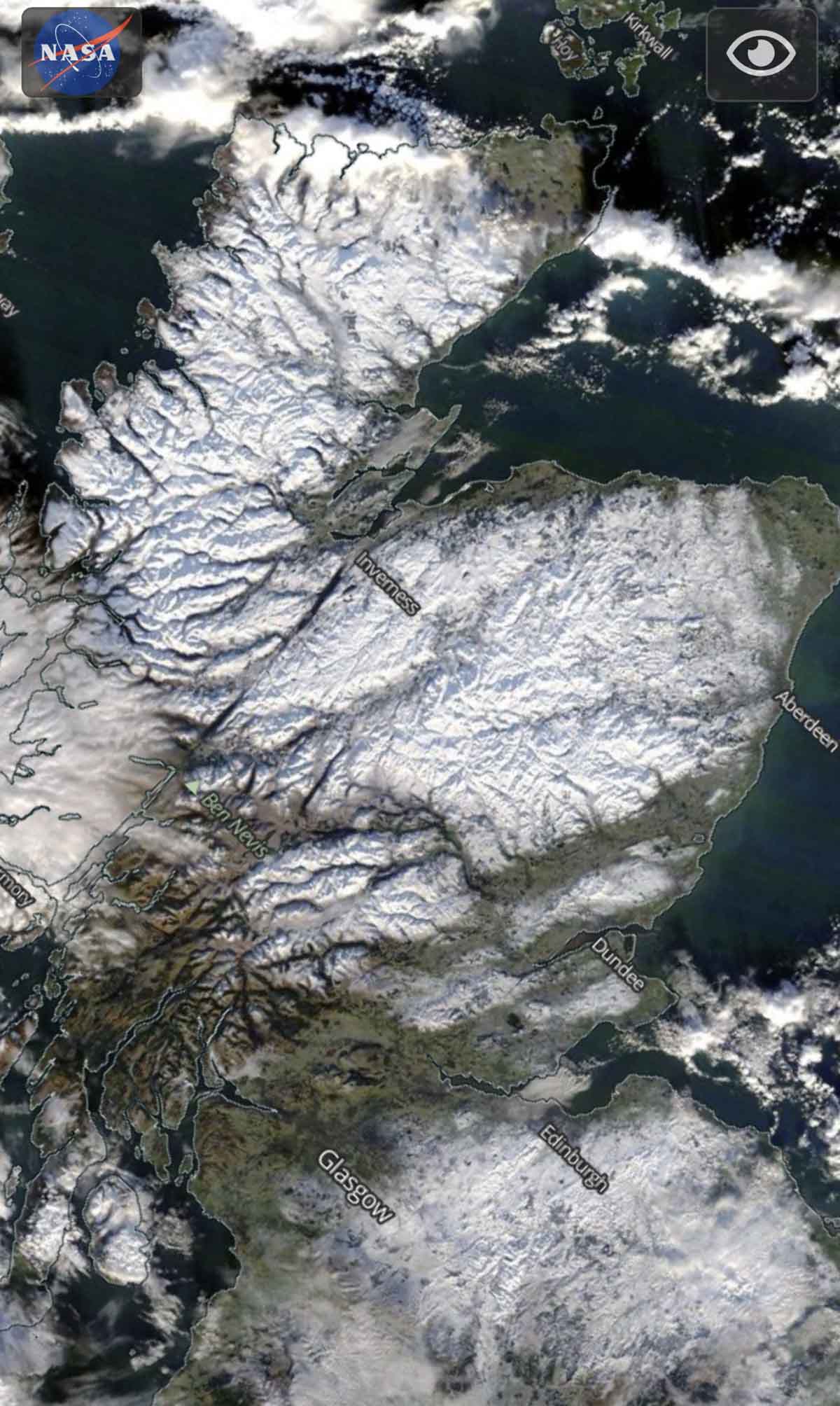
Because of the changes in the solar elevation and the global radiation with time and geographical location, the albedo effect on the surface radiation balance, thus the surface temperature, also changes spatially and temporally.
The importance of albedo feedback is marginal in polar areas during winter.
This is because, during this season, the sun stays consistently below the horizon. But as you go south, it becomes progressively crucial. For instance, the albedo effect is essential if the UK, Germany, or Texas are covered in snow.
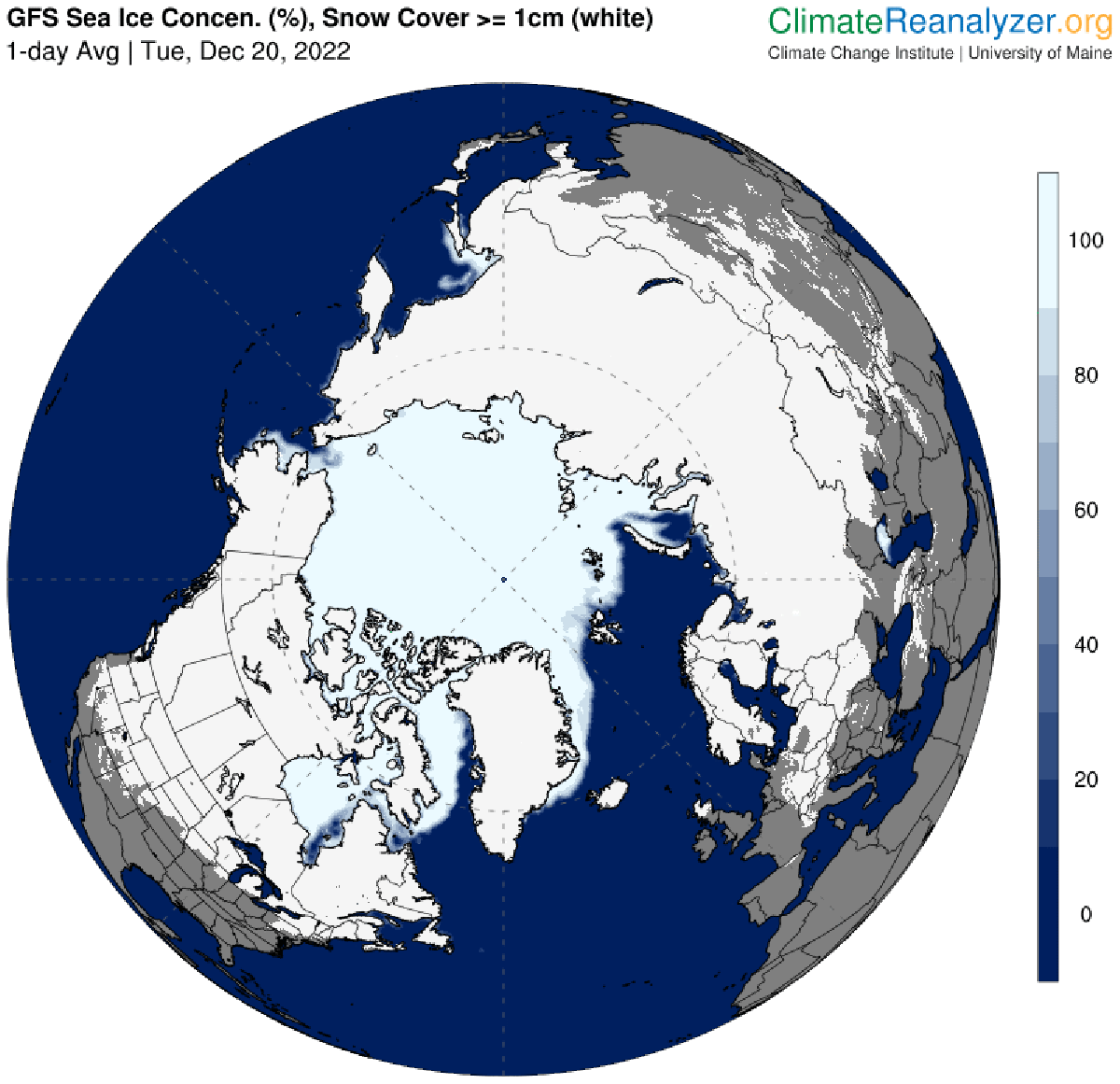
But besides albedo, snow also has a high emissivity that cools the ground. Over the thermal infrared part of the radiative spectrum, snow acts almost as a “blackbody.” More simply, this means that the snow emits a specific, uniform, and constant electromagnetic radiation, which depends upon the body’s temperature (in this case, the snow).
The emissivity of snow varies from 0.96 to 0.99, with an average of about 0.98. Without going too much into the details, we can say that such value is generally higher than any other land surface emissivity. This means when the ground is covered by snow, the higher emissivity of a snow surface causes an increase in the outgoing longwave radiation, thus cooling the snow surface.

The overall impact of snow cover on the ground thermal regime depends on several factors as the timing, duration, accumulation, and melting processes of seasonal snow cover. In general, cold, dry, and clear-sky conditions generate higher emissivity of the snow surface, resulting in surface cooling and, very often, the development of a low-level temperature inversion.
This is, for instance, how the well-known Siberian High forms at this time of the year. The Siberian High is a massive pool of cold, dry air that accumulates in the northeastern part of Eurasia from September until April.
It is usually centered on Lake Baikal. It reaches its greatest size and strength in the winter when the air temperature near the center of the high-pressure area is often lower than −40 degrees Celsius. The Siberian High is Eurasia’s most critical atmospheric center of the action during the winter months.
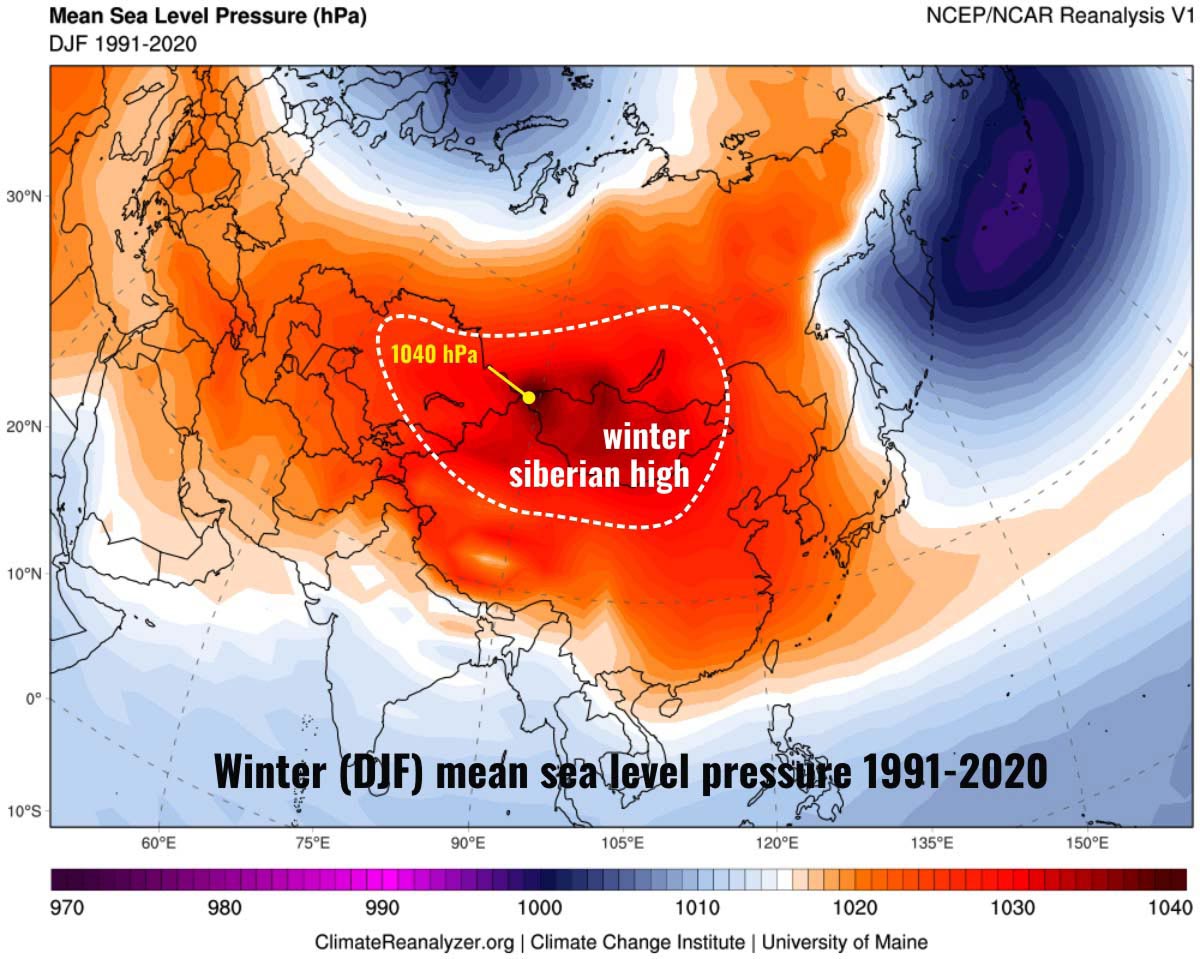
HOW SNOW FORMS
Clouds in the sky form when water vapor, an invisible gas, condenses and turns into liquid water droplets or ice crystals. Water vapor needs to stick to the so-called condensation nuclei to do so. When water vapor in the atmosphere condenses directly into ice, bypassing the liquid phase, the resulting forms are properly called snow crystals.
Snowflakes, a more general meteorological term, are anything from individual snow crystals to agglomerations of many crystals that collide and stick together, falling to the ground as flimsy puffballs. Snowflakes that descend through moist air slightly warmer than 0 °C will melt around the edges and stick together to produce big flakes. In the image below, you can visualize the eight main steps from the first tiny ice crystal to the composite snowflake.
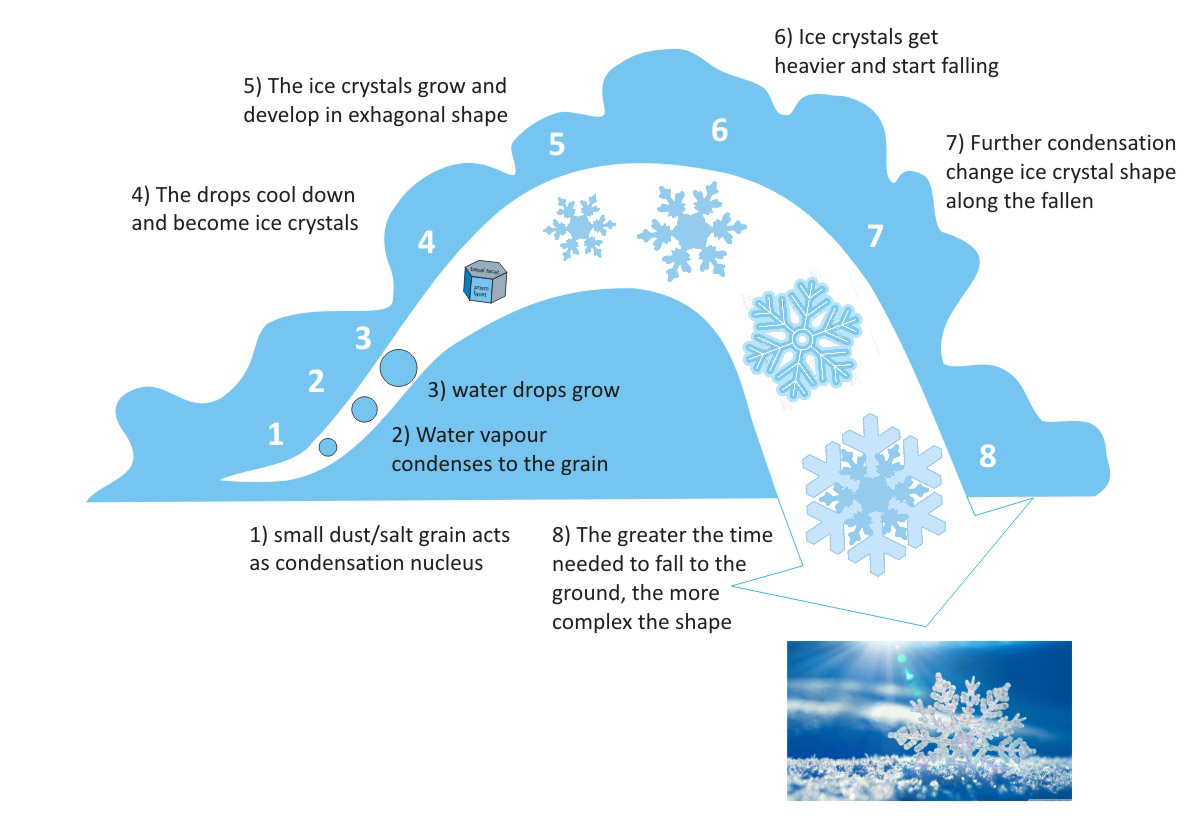
Although the general theory is well known, the formation of atmospheric snow crystals remains a largely unsolved problem. The morphology diagram below qualitatively describes the growth of snow crystals as a function of temperature and water vapor supersaturation.
Snowflake shape strictly depends on temperature formation. Thin, flat, stellar-dendrite snow crystals are almost always taken in a narrow temperature range near −15°C. Slender columnar and needle-like crystals appear only when the temperature is near −5°C. Composite snow crystal types, like the capped column, form when growth conditions change as the crystal develops. No matter the temperature at the ground surface, the shape of a snowflake depends on conditions in the cloud.

Hygroscopic nuclei have sizes from 0.01 to 10 micrometers. One micrometer, also known as a micron, equals one-millionth of a meter. In the classification by size, the smallest is called Aitken nuclei, having diameters less than 0.4 micrometers with concentrations of 1000-5000 every cubic centimeter. They are so small that a high degree of supersaturation is required for the vapor condenses on them.
Large nuclei, on the other hand, have diameters 0.4-1 micrometer and concentrations of a few hundred per cubic centimeter. Giant nuclei have diameters of 1-10 micrometers and concentrations of just 0.1-1 per cubic centimeter. The picture below shows how small the water molecules are compared to condensation nuclei.

The main group of hygroscopic nuclei is salt, whose primary source is the sea when the waves break. Their concentration increases with increasing wind speed on which the wave motion depends. Equally numerous droplets of salt water are expelled into the atmosphere by intense evaporation when the lava of some effusive volcanoes like in Hawaii reaches the sea surface.
Another group of nuclei is all those particles composed of sulfates present in the atmosphere as products of the combustion of other substances.
The particles that the winds remove from the ground constitute a third important source of nuclei. Those with diameters greater than 10-20 micrometers fall quickly to the ground due to their weight, while the smaller ones can be transported to great heights and large distances.

Extreme snowfall events remain a major damaging category of extreme weather events, particularly in the northern hemisphere. Extreme Snowfall is a distinct case of precipitation since the predicted strengthening of the hydrological cycle allows for potentially more snowfall as long as temperatures remain sufficiently cold for snow to occur. This is the case of the winter storm Elliot, which will develop soon.
WINTER SNOW EXTENT INCREASES IN THE LONG TERM
What we observe this year seems to fit with the recent Fall Snow Extent trend observed in North America and Eurasia. As can be seen from the images below showing the snow extent in the Northern Hemisphere, in the late 1960s, the average was slightly above 48 million square kilometers, while now increased by a bit less than 1 million square kilometers on average, and it is close to 49 million square kilometers.
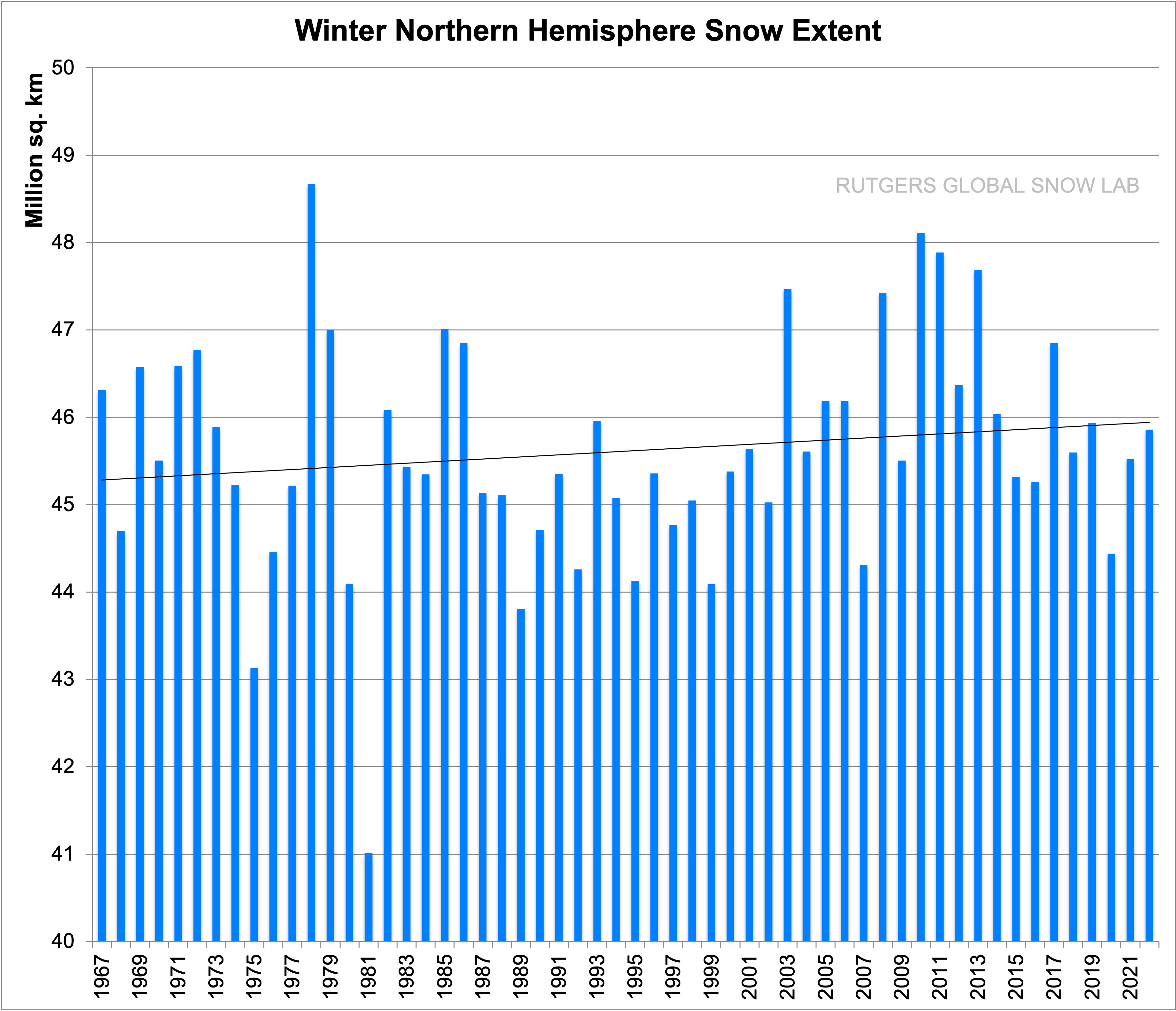
In North America, the snow extent in Winter rose from about 17 million square kilometers to 17.4 million square kilometers. In Eurasia, the snow extent increased by about 0.3 million square kilometers. It was 28.2 million square kilometers in late 1960 and now around 28.6 million square kilometers. Nevertheless, the annual variability is very large.

A LOT OF MORE SNOW IS FORECAST FOR CHRISTMAS IN THE USA, AND THE NORTHERN HEMISPHERE
We use the global model ECMWF to forecast how the snow extent might develop in the next two weeks. Western Europe is facing a fast snow extent reduction after the Arctic freeze ended a few days ago.
A surge of warm air across central Europe with widespread westerlies strengthening. Some places in Central Europe and the UK experienced more than +20°C temperature drop from one night to the next few days. This led to a sudden melting of the pre-existing thin snow layer.
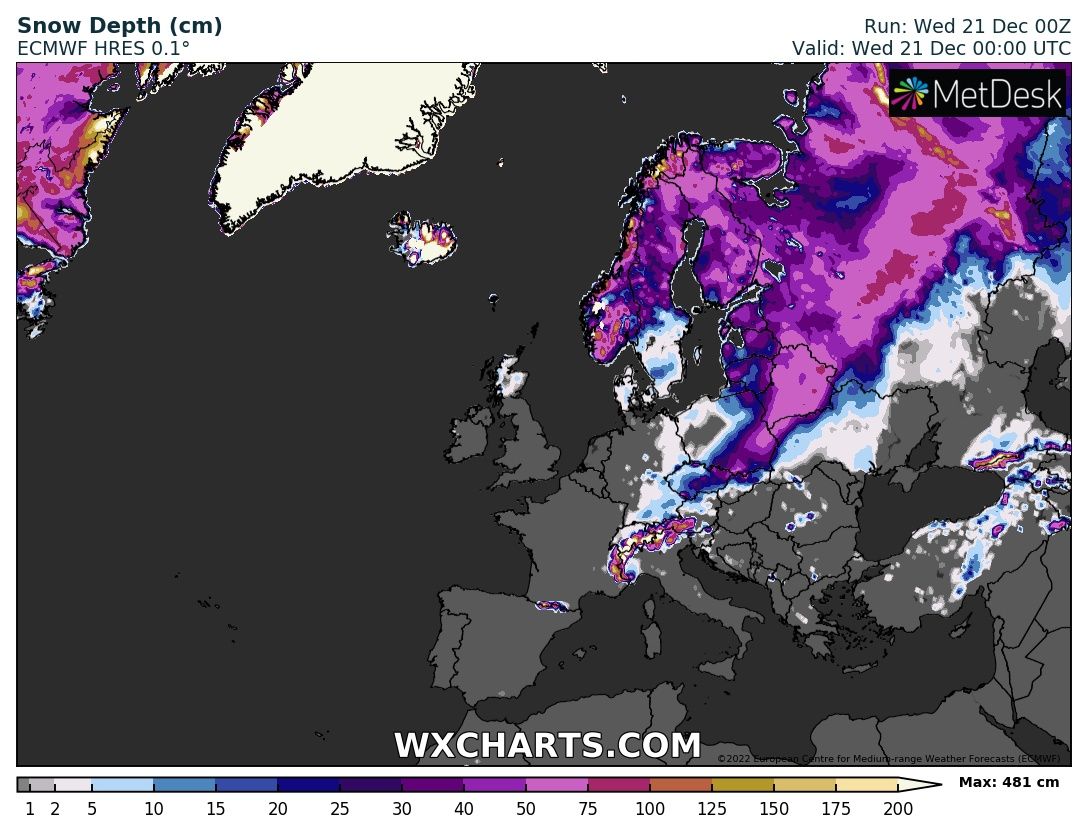
Snow depth and extended forecast for Europe according to the global model ECMWF valid December 21
The melting process will continue across Eastern Europe in the next few days, progressively reached by the surge of warmth. By the end of December, Europe will likely lose something like 0.4 to 0.6 million square kilometers of snow extent.
The image below shows how a significant melting will affect central and southern Poland, the Check Republic, and southern Germany in the following weeks. On the other hand, more snow will cover a large part of Turkey by the end of 2022.
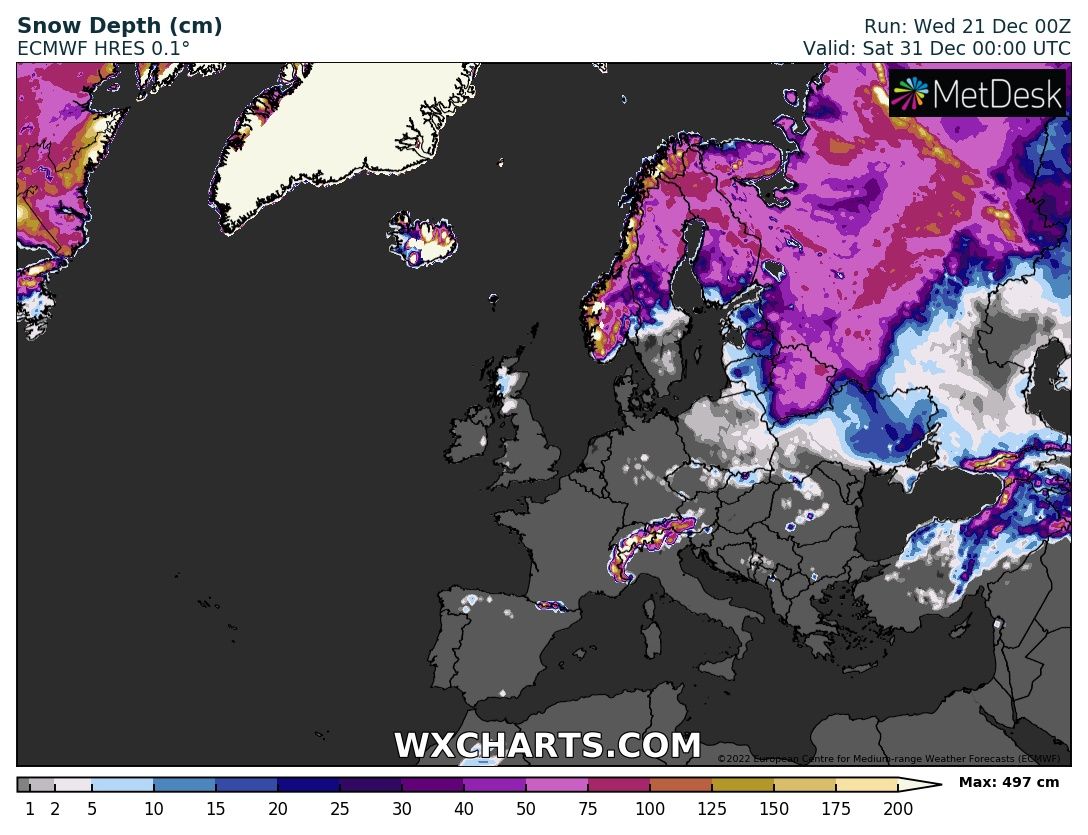
Snow depth and extent forecast according to the global model ECMWF valid December 31
The developing weather situation across North America with the winter storm Elliot and thanks to the interaction of the Arctic frigid air mass with warmer and moist air mass will provide sufficient energy for an impressive cyclonic system to develop straight away.
This considerable winter storm Elliott will bring widespread blizzards with a lot of new snow covering the ground. The snow extent in North America will therefore face an imminent increase in the next few days and before Christmas.
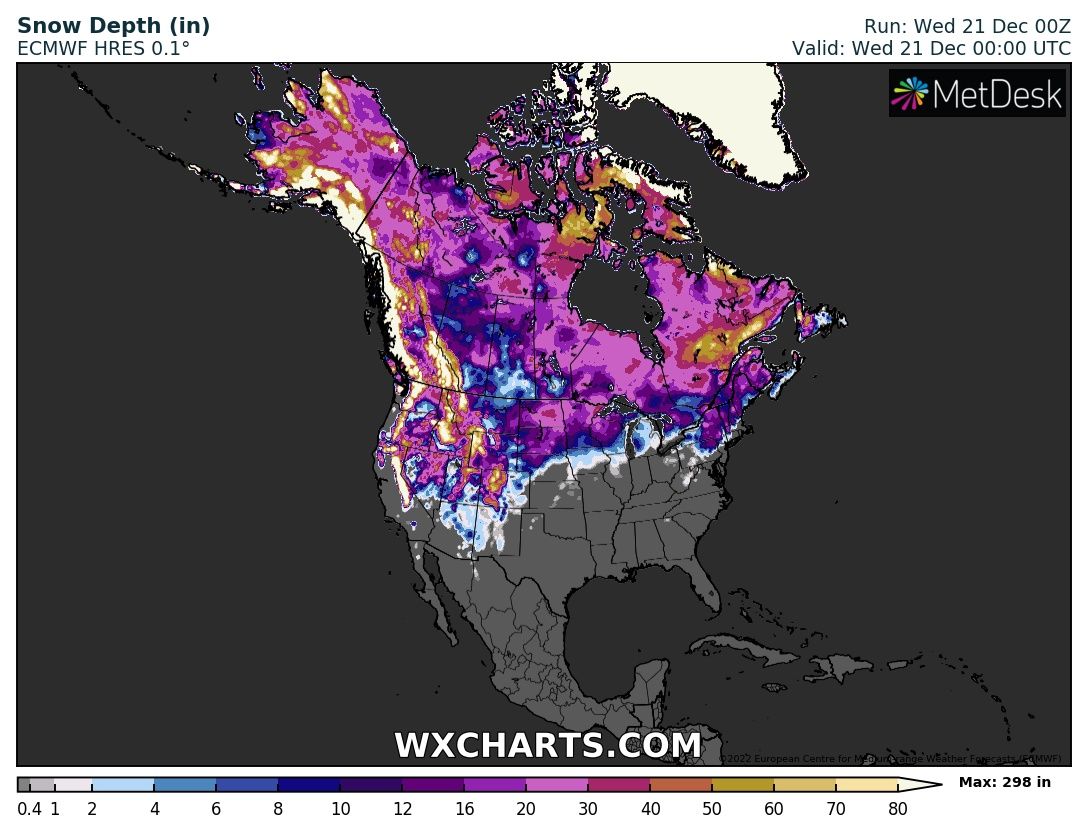
Snow depth and extended forecast for North America according to the global model ECMWF valid December 21
ECMWF forecast shows as the snow extent in the U.S. will spread 600-800 kilometers south in a few days from central Nebraska to northeast Oklahoma as well as from South Wisconsin to North Tennessee and from Michigan towards North Carolina.
This means the snow cover extent in the US will grow by about 1 million square kilometers within a few days, followed by frigid conditions.

Snow depth and extended forecast for North America according to the global model ECMWF valid December 28
Snow is on its way to covering a large part of Asia, especially China. The province of Sichuan, Guizhou, and Yunnan in China will experience heavy snow around Christmas and the days immediately after when an outbreak of frigid air from Siberia will interact with milder and moist air from Laos and Vietnam.
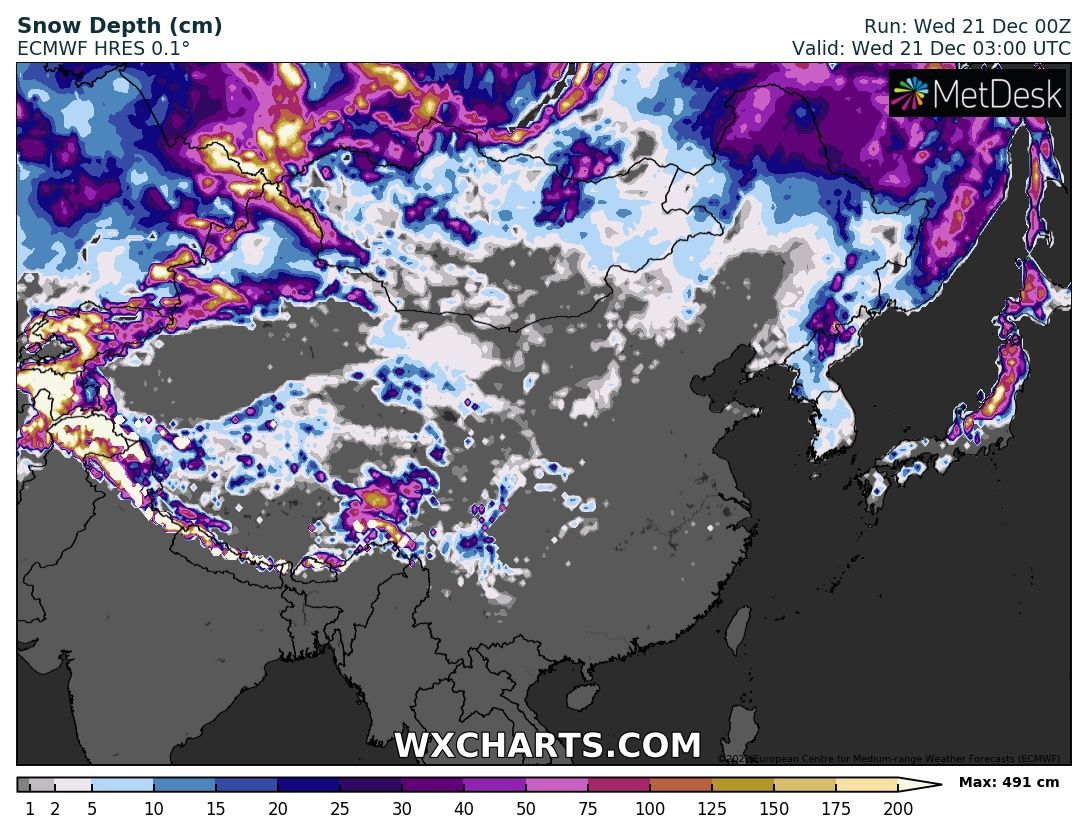
Snow depth and extended forecast for China and part of South Asia according to the global model ECMWF valid December 21
The total area receiving a new snow cover in China is about 0.7 to 0.8 million square kilometers. Doing the math and considering North America, Europe, and Asia, the Northern Hemisphere will increase its current snow extent by about 1.2 to 1.4 million square kilometers in a few days. The total northern hemisphere snow extent will thus likely reach about 46.5 million square kilometers by Christmas or right after.

Snow depth and extended forecast for China and part of South Asia according to the global model ECMWF valid December 31
We will keep monitoring the winter snow extent in the winter season 2022/23, which has been interesting this year. After the fourth-largest Northern Hemisphere snow extent on the record set in November, let’s see what the winter forecast will bring next.
We will keep you updated on this and much more, so bookmark our page. Also, if you have seen this article in the Google App (Discover) feed or social media, click the like button (♥) to see more of our forecasts and our latest articles on weather and nature in general.
Wxcharts provided images used in this article.
